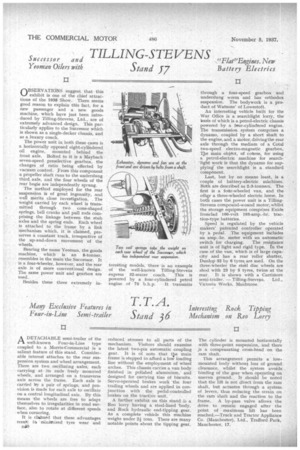T.T. A.
Page 64

If you've noticed an error in this article please click here to report it so we can fix it.
Stand 36 ADETACHABLE semi-trailer of the well-known Four-in-Line type coupled to a Morris-Commercial is a salient feature of this stand. Considerable interest attaches to the rear suspension system and wheel arrangement. There are two oscillating axles, each carrying at its ends freely mounted wheels, and arranged on a transverse axis across the frame. Each axle is carried hy a pair of springs, and prOvision is made for each axle to oscillate on a central longitudinal axis. By this means the wheels are free to adapt themselves to irregularities in road surface, also to rotate at different speeds
• when cornering.
It is claimed that these advantages resul.t in Minigfized tyre wear and
reduced stresses to all parts of the mechanism. Visitors should examine the latest two-pin automatic coupling gear. It is of note that ve main frame is stepped to afford a low loading line without the employment of wheel arches. This chassis carries a van body finished in polished aluminium, and designed for carrying tins of biscuits. Servo-operated brakes work the four trailing wheels and are applied in conjunction with the pedal-controlled brakes on the tractive unit. '
A further exhibit on this stand is a Reo lorry having a steel-lined body, and Rock hydraulic end-tipping gear. As a complete vehicle this machine weighs under 2-/ tons. There are many notable points about the tipping gear. The cylinder is mounted horizontally with three-point suspension, 'and there a compensating cross-head on the ram shaft. • This arrangement permits a low. mounted body without loss of ground clearance, whilst the system avoids binding of the gear when operating on uneven ground. It should be noted that the lift is not direct from the ram shaft, but actuates through a system of levers, thus reducing the strain on the ram shaft and the reaction to the frame. A by-pass valve allows the drive to remain engaged after the point of maximum lift has been reached.—Truck and Tractor Appliance Co. (Manchester), Ltd., Trafford Park, Manchester, 17,


















































































